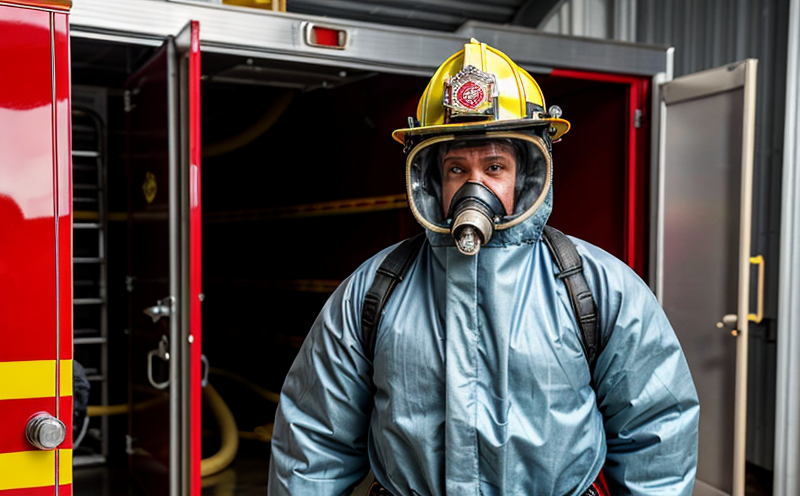Impact Resistance Testing of Helmets
The impact resistance testing of helmets is a critical component in ensuring firefighter protective clothing and equipment meet stringent safety standards. This test evaluates the ability of firefighting helmets to withstand high-impact forces, thereby protecting firefighters from potential head injuries during hazardous operations.
During this testing procedure, helmets are subjected to controlled impacts using specialized impact testers that simulate real-world conditions encountered by firefighters. The standard apparatus used for this purpose includes an impact tester capable of delivering a specified force at a defined velocity. The specimen (the helmet) is positioned in accordance with the relevant international standards such as ASTM F2091 and ISO 6874, ensuring accurate and consistent results.
The testing process involves several critical steps to ensure reliable outcomes. Initially, the helmets are carefully prepared by cleaning them according to specified guidelines to remove any potential external contaminants that could affect the test results. Once cleaned, the helmets undergo a series of impact tests where they are subjected to various forces and velocities to determine their resistance capabilities.
The impact tester used in this process is typically equipped with a pendulum hammer capable of delivering impacts ranging from 500 joules up to 2000 joules. The helmet is placed on the testing machine, ensuring it aligns correctly for accurate measurement and observation. After each test, detailed observations are made regarding any deformations or structural changes in the helmet.
The results of these tests provide crucial insights into the performance of helmets under impact conditions. Compliance with international standards ensures that firefighters have reliable protective equipment that can withstand real-world hazards effectively. This testing process not only enhances safety but also helps in continuous improvement and development of better protective gear for firefighters.
- ASTM F2091: Standard Specification for Firefighter Protective Head Protection
- ISO 6874: Specifications for Firefighters' Helmets
Scope and Methodology
The scope of impact resistance testing encompasses the evaluation of helmets designed specifically for firefighters. This includes assessing their structural integrity under high-impact forces that might be encountered during firefighting operations. The methodology involves a series of controlled tests to simulate various real-world scenarios where helmets could face significant impacts.
The testing procedure begins with selecting an appropriate impact tester capable of delivering the required force at a specified velocity. The helmet is then securely mounted on the testing apparatus in accordance with industry standards. A pendulum hammer strikes the helmet from above, simulating potential impacts that firefighters might encounter while performing their duties.
During each test, detailed observations are made regarding any visible changes or deformations in the helmet structure. These observations are crucial for evaluating the helmet's performance and ensuring it meets the specified safety requirements. After completing a series of tests, the data collected is analyzed to determine compliance with relevant international standards such as ASTM F2091 and ISO 6874.
The results of these tests are reported comprehensively, providing clear insights into the helmet's resistance capabilities against impacts. This information is vital for quality managers, compliance officers, and R&D engineers responsible for ensuring that protective gear meets stringent safety standards. By adhering to these rigorous testing protocols, manufacturers can continuously improve their products, enhancing overall firefighter safety.
Industry Applications
The application of impact resistance testing in the fire safety sector extends beyond mere compliance with international standards. This testing plays a pivotal role in safeguarding firefighters' lives by ensuring they have reliable protective equipment that can withstand severe impacts encountered during firefighting operations.
In real-world scenarios, helmets are subjected to various forms of impact forces, including those from falling objects or collisions with hard surfaces. The results of these tests provide essential data for quality managers and compliance officers responsible for maintaining high standards in the production and distribution of protective gear. By leveraging this information, they can make informed decisions regarding product improvements and ensure that all helmets meet the necessary safety criteria.
R&D engineers benefit significantly from impact resistance testing as well. They use the results to identify areas where current designs can be enhanced or modified to improve overall performance. This continuous improvement process is crucial for maintaining cutting-edge technology in firefighting equipment, ultimately contributing to better protection and reduced risk for firefighters.
Procurement teams also rely heavily on impact resistance testing data when selecting suppliers and sourcing products. By prioritizing helmets that have successfully passed rigorous tests, they ensure that the gear purchased meets stringent safety standards. This approach not only enhances operational efficiency but also fosters a culture of safety within firefighting organizations.
International Acceptance and Recognition
- ASTM F2091: Standard Specification for Firefighter Protective Head Protection
- ISO 6874: Specifications for Firefighters' Helmets
- Australian Standard AS/NZS 1930.5:2009
- European Standard EN 397:2003
The international acceptance and recognition of impact resistance testing for helmets are paramount in ensuring the safety and effectiveness of firefighting equipment worldwide. These tests, conducted according to established standards such as ASTM F2091 and ISO 6874, have gained widespread acceptance across various countries.
Countries like Australia and New Zealand follow their own national standards (AS/NZS 1930.5:2009) for firefighter protective headgear, which are aligned with international guidelines to ensure consistency in safety protocols. Similarly, European Union regulations mandate compliance with EN 397:2003, further emphasizing the importance of these tests.
The global recognition of these standards ensures that firefighters around the world have access to high-quality protective equipment that meets the highest safety standards. This uniformity in testing procedures contributes significantly to enhancing firefighter safety and reducing the risk associated with hazardous operations.





